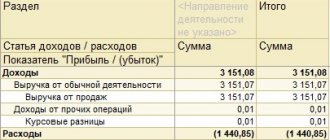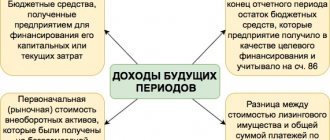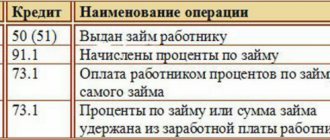The letter combination “NEOPL” is a symbol for one of the codes that must be included in the reporting documents regarding the length of service. With the help of “NEOPL”, periods are recorded for which the employee was not paid for various reasons . This type of encoding was introduced by Resolution of the Board of the Pension Fund of the Russian Federation No. 66p dated March 28, 2012 and is currently used.
Such encoding, which also includes the symbol “NEOPL,” makes it possible to identify working citizens and their working conditions during the consideration of personalized information by the Pension Fund. The coding used allows us to take into account all the facts of each employee’s work activity (experience, earnings, etc.) and thus adequately approach the assignment of a pension.
The “NEOPL” code is relevant not only for working Russian citizens, but also for foreigners who reside temporarily or permanently, and also work in the territory of the Russian Federation. Such workers are also registered in the compulsory pension insurance system. And individual information is provided on them in the generally accepted manner.
Thus, a company has the right to conclude an employment contract with a foreigner who is temporarily staying in the Russian Federation. If the employment agreement is valid for at least 6 months, then the foreign worker will already be considered insured. Consequently, he will also be subject to all the rules for processing individual information using the appropriate codes, including “NEOPL”.
Personalized accounting
Personalized accounting is intended to summarize the data on the personal account of each employee (from the moment of his employment) for the insurance and funded parts of the pension.
Data on his work experience is recorded on the same account. The main regulatory document for such accounting is the Law “On individual (personalized) accounting in the compulsory pension insurance system” dated April 1, 1996 No. 27-FZ.
The source of data for personalized accounting is information submitted by employers.
Periods of sickness and vacation at your own expense must be shown in RSV-1 for 2015
09 February 2016
When filling out RSV-1 PFR 2015, accountants have questions. One of the frequent questions is whether it is necessary to reflect periods of sickness and vacation at one’s own expense in the RSV-1 report for the 4th quarter of 2015.
In order to fill out the RSV-1 report for the 4th quarter of 2015, it is said that columns 5–9 of subsection 6.8 need to be filled out only in information about workers who work in hazardous conditions (clause 37.6 of Appendix 2 to the resolution of the PFR board of January 16, 2014 No. 2p ). But the fund specialists we interviewed believe that periods of sickness and personal leave should be reflected in section 6, even if the employee has normal working conditions. Each period in column 7 of subsection 6.8 must be marked with a special code. For illness - code VRNETRUD, for leave at your own expense - NEOPL.
If you do not show periods of illness and vacation, then during the inspection the fund may fine the company 5 percent of the employee’s contributions reflected in subsection 6.5 (Art.
17 Federal Law dated 01.04.96 No. 27-FZ). Judges consider such fines legal.
When filling out DAM 1 for the 4th quarter of 2015, you need to double-check everything carefully so that after sending DAM 1 for the 4th quarter of 2015, a negative protocol does not come from the fund. Most often, as we found out from Pension Fund specialists, the errors are as follows: the contribution base diverges, tariff codes are mixed up, etc. (see article on the website). They should be corrected and the calculation sent again. If a company sends a report with errors on time and corrects them after the deadline allotted for submitting the RSV-1 report to the Pension Fund of Russia, then a fine is possible. In some regions, it can only be canceled in court.
The telephone number of the PFR management hotline in the Golyshmanovsky district of the Tyumen region is 2-50-31
Branch page on the social network “VKontakte”
By Resolution of the Board of the Pension Fund of March 28, 2012 No. 66p, the following changes were made to the Resolution of the Board of the Pension Fund of 31.07.2006 No. 192p “On the forms of documents for individual (personalized) registration in the compulsory pension insurance system and Instructions for filling them out”:
Changes to the rules for filling out forms ADV-6-2 “Inventory of information transferred by the policyholder to the Pension Fund” and ADV-6-3 “Inventory of documents on accrued and paid insurance premiums and the insurance experience of insured persons transferred by the policyholder to the Pension Fund”.
These forms must be filled out in rubles and kopecks.
In addition, the table of details of the ADV-6-2 form is supplemented with the lines “Amount of additionally paid insurance contributions for the insurance part of the labor pension” and “Amount of additionally paid insurance contributions for the funded part of the labor pension,” which indicate the amount of additionally paid insurance contributions for the reporting period. In this case, the values of the indicators in these lines can be both positive and negative.
2. The procedure for submitting and the rules for filling out form SZV-6-1 “Information on accrued and paid insurance contributions for compulsory pension insurance and the insurance experience of the insured person” have been clarified regarding the procedure for submitting corrective or canceling forms.
3. Changes have been made to the Classifier of parameters used in the forms of individual (personalized) accounting documents in the compulsory pension insurance system, including to reflect information:
– for crew members of ships registered in the Russian International Register of Ships for performing the duties of a ship crew member;
– for foreign citizens or stateless persons (with the exception of highly qualified specialists in accordance with Federal Law No. 115-FZ of July 25, 2002 “On the Legal Status of Foreign Citizens in the Russian Federation”), temporarily residing on the territory of the Russian Federation and having entered into an employment contract for an indefinite period or a fixed-term employment contract for a period of at least six months;
– Law of July 25, 2002 No. 115-FZ “On the legal status of foreign citizens in the Russian Federation”), temporarily staying on the territory of the Russian Federation and having entered into an employment contract for an indefinite period or a fixed-term employment contract for a period of at least six months.
In addition, the categories of persons applying preferential rates of insurance contributions according to the PNED code have been clarified, and new codes have been added, in particular, DP - for voluntary contributions to the Pension Fund of the Russian Federation paid by the employer for employees, ASB - for pharmacy organizations, social service organizations and charitable organizations .
The classifier has been supplemented with a new table “Calculable length of service: calculation of WORK experience: additional information (for forms SZV-6-1, SZV-6-2) (periods not included in the insurance period)”, which includes 3 additional codes:
CHILDREN - parental leave from 1.5 to 3 years;
Chernobyl Nuclear Power Plant - Additional leave for citizens exposed to radiation as a result of the disaster at the Chernobyl nuclear power plant;
NEOPL - Vacation without pay, downtime due to the fault of the employee, unpaid periods of suspension from work (non-admission to work), unpaid leave of up to one year provided to teaching staff, one additional day off per month without pay provided to women workers in rural areas, unpaid time for participating in a strike and other unpaid periods, except for periods with codes DLDETI and Chernobyl NPP.
4. The forms “Request from the body providing pension provision for an extract from the individual personal account of the insured person (form SZV-2a)” and “Extract from the individual personal account of the insured person (form SZI-5)” are set out in a new edition in accordance with Appendices 1 and 2 to this resolution.
These changes must be used as a guide when preparing reports on individual (personalized) accounting, starting with reports for the first quarter of 2012.
You can find out more about the procedure for filling out personalized accounting forms in the book “PERSONALIZED ACCOUNTING-2012”
Features of personalized reporting in 2020
Starting from 2021, reporting regarding the calculation of insurance premiums (including those intended for the Pension Fund of Russia) is submitted to the tax authorities. The calculation of contributions, which combines information on all types of contributions transferred under the control of the Federal Tax Service, contains a section devoted to personalized data. However, these data only include information on accrued income for the period and related contributions. There is no information about experience in them.
Read about the new reporting on contributions in the article “ERSV - calculation of insurance premiums for 2021 in 2021.”
Reporting on length of service is submitted at the end of the year directly to the Pension Fund of the Russian Federation before March 1 (clause 2 of Article 11 of Law No. 27-FZ of April 1, 1996). For it, by resolution of the Board of the Pension Fund of December 6, 2018 No. 507p, a new form SZV-STAZH was approved, in which for information about length of service a table is provided, similar to that included in the expired form RSV-1.
Our checklist will help you fill out the SZV-STAGE for 2021.
By the way, before the end of the year, the liquidating organization and the individual entrepreneur deregistering must submit the SZV-STAZH.
See: “Forms SZV-STAZH and EDV-1 are submitted upon liquidation of a company or individual entrepreneur . Is it necessary to take the SZV-STAZH when dismissing an employee? Find out here .
Resolution No. 507p approved the rules for filling out and formats for submitting it to the Pension Fund. The text of the rules contains a reference to the same codes that were used when filling out personalized information in the RSV-1.
DLDETI: decoding
The insurance period for the purposes of assigning an insurance pension includes not only periods when a person worked under an employment contract (Part 1 of Article 11 of Law No. 400-FZ dated December 28, 2013), but also when he did not directly perform his labor function, although the employment contract continued to act with him.
These are, for example, periods of receiving compulsory social insurance benefits for temporary disability, as well as periods of one parent caring for a child until he reaches the age of one and a half years, but not more than six years in total if there are several children in the family (clause 2 ,3 part 1 article 12 of the Law of December 28, 2013 No. 400-FZ, article 256 of the Labor Code of the Russian Federation). At the same time, at the end of leave to care for a child up to one and a half years old, a parent has the right to take leave to care for a child up to three years old (Article 256 of the Labor Code of the Russian Federation). That is, in total, a parent can be on leave for a maximum of 3 years. At the same time, the second half of this vacation is no longer included in the insurance period. Accordingly, one and the other leave must be noted in the employee’s individual information, namely in subsection 6.8 of section 6 of RSV-1, differently.
Therefore, when granting parental leave (clause 37.19 of the Procedure for filling out the RSV-1):
- up to one and a half years old, the code “CHILDREN” is indicated to the mother or father of the child;
- from one and a half to three years of age, the mother or father of the child is given the code “DDILID”;
- up to three years of age, another relative of the child or his guardian is indicated with the code “CHILDREN”. After all, such leave can be granted, for example, to a working grandmother or grandfather when caring for a grandchild, as well as to another relative (clause 19 of the Resolution of the Plenum of the Supreme Court of the Russian Federation dated January 28, 2014 No. 1).
Where are the types of codes indicated?
Grouped by sections, the codes of the parameters required to fill out information about the length of service are contained in clause 2.3.26 to the Pension Fund Resolution No. 507 p dated December 6, 2018:
- insured persons by category;
- taking into account working conditions in the territories of the Far North and those exposed to radiation contamination;
- for special working conditions;
- on the basis for calculating the insurance period;
- according to additional information for calculating the insurance period;
- for periods that are not included in the insurance period when calculating the length of service;
- on the grounds for assigning a labor pension early;
- for a special assessment of working conditions.
The parameter classifier is intended to identify employees and the conditions of their work when considering personalized data in the Pension Fund. It allows you to ensure the assignment of a pension taking into account all factors (earnings, length of service, working conditions, etc.).
The classifier also includes codes for such categories of insured persons as foreign citizens temporarily residing in the territory of the Russian Federation.
Read about what statuses foreign citizens can have in Russia in the article “Hiring foreign citizens (nuances).”
Neopl transcript PFR 2021
DECREE Maternity leave Paragraph one of Article 255 “Maternity leave” of the Labor Code of the Russian Federation (Collected Legislation of the Russian Federation, 2002, No. 1 (Part I), Art. 3; 2006, No. 27, Art. 2878) ; Subparagraph 2 of paragraph 1 of Article 11 “Other periods counted in the insurance period” of the Federal Law of December 17, 2001 N 173-FZ “On Labor Pensions in the Russian Federation” from 01/01/2014 to 12/31/2014 Paragraph one of Article 255 “Maternity and Maternity Leave” childbirth" of the Labor Code of the Russian Federation; Clause 2 of Part 1 of Article 12 “Other periods counted in the insurance period” of the Federal Law of December 28, 2013 N 400-FZ “On Insurance Pensions” from 01/01/2015 (as amended
Resolutions of the Board of the Pension Fund of the Russian Federation dated 06/04/2015 N 194p) (see.
“Neopl” and “Agreement” in personalized accounting
The “Neople” code is used if there were periods during which no work was carried out. Such periods are:
- leave without pay;
- downtime due to the employee’s fault;
- suspension from work in case of violations of labor regulations (for example, state of intoxication);
- unpaid leave of up to one year provided to teachers;
- other unpaid periods.
The “Contract” code is entered if work under the contract began in the previous reporting period and continues in the current one. It is used for contracts, transportation and others.
Neopl transcript PFR 2021
Displaying the unpaid period of work for 2021 using the code “NEOPL” (the old RSV-1 form is used) Employee Klimova L.N. has been on maternity leave since the beginning of 2016.
Since she did not provide a sick leave certificate to her employer, she was not awarded maternity benefits. When filling out the RSV-1 form, namely, section 6.8 (“Period of work for the last three months”), this is the considered period of labor activity of L. Klimova.
N. can be displayed using the following codes:
- “NEOPL” - from the date of her leave in 2021 and until Klimova L.N. brings the required documents for the assignment of benefits.
- “DECREE” - with a calculation for the quarter in which the employee will submit documents to the employer, and she will be given an allowance.
- “CHILDREN” - from the date when Klimova
L.N.
Results
“Neopl” is a code used in reporting on length of service to display periods in which the employee did not work. And the "Administrator" code is its predecessor, which is not currently used. You can find a complete list of codes in Appendix 2 to the Pension Fund Resolution No. 2p dated January 16, 2014. And in the resolution of the Pension Fund of the Russian Federation dated December 6, 2018 No. 507p, which approved the new forms SZV-STAZH, SZV-ISKH, ODV-1, SZV-KORR - the current codes.
Sources: Law “On individual (personalized) registration in the compulsory pension insurance system” dated April 1, 1996 No. 27-FZ
You can find more complete information on the topic in ConsultantPlus. Free trial access to the system for 2 days.
Answers to frequently asked questions
Question No. 1: What code should be written down in the employee’s individual information to display leave at his own expense, “ADMINISTER” or “NEOPL”?
Until April 1, 2015, the code “ADMINISTER” was used for this purpose, after which it was canceled and “NEOPL” was introduced instead. Thus, non-working days of an employee who has taken leave without pay are marked with the symbol “NEOPL” (Resolution of the Board of the Pension Fund of the Russian Federation No. 194p dated 06/04/2015).
Question No. 2: Does an organization need to keep and submit personalized records for an employee who is a pensioner?
Need to. The law does not provide any exceptions for anyone in this regard. A pensioner is a worker like everyone else. Individual data for pensioners is processed in the same manner as for all working citizens, as required by law (
How to reflect in SZV-STAZH employees fired for absenteeism
If an employee is fired for absenteeism without a valid reason, special attention is paid to column 7 SZV-STAGE: period of work. Accountants often make a mistake and indicate the date of the application or order of dismissal as the last day. That's right - write the last day the employee went to work.
For example, Igor Valentinovich Barankin stopped coming to work on August 10, and it was not possible to contact him. On August 15, the organization unilaterally issued a decision on dismissal. In SZV-STAZH the working period is indicated until August 9 (the last day that Barankin was at work), and not August 15, when the dismissal order was signed.
Any absence for an unclear reason from a legal point of view is absenteeism, leading to a break in continuous service. It can be reflected in SZV-STAZH in two ways, but the priority is to indicate the period of absence from work with the mark “NEOPL”.
Please note the consistency of information in SZV-M and SZV-STAZH. If discrepancies are detected, the supervisory authority will send a notice requiring corrections to be made and issue a fine to the organization.
To correctly reflect absences for unknown reasons and absenteeism at SZV-STAZH, use the “My Business” service for accountants and entrepreneurs. It automates reporting preparation and eliminates the possibility of errors.








